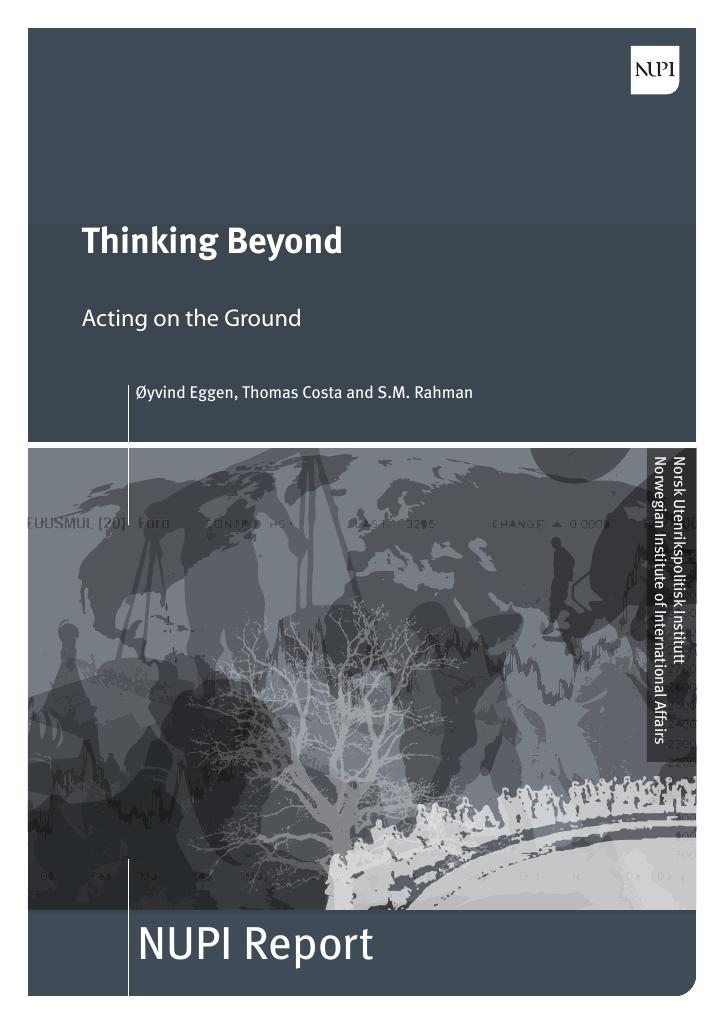Evaluering
Thinking Beyond – Acting on the Ground
Background: The Integrated-Programme for Community Capacity Building (ICCB) of the Bangladesh Northern Evangelical Lutheran Church Development Foundation (DF) has been under implementation since 2008. This mid-term evaluation was commissioned by Normisjon, the sole donor to the program. The Adivasi people and the poorest households of Bangali communities in six northern districts of Bangladesh actively participate in community organizations for improving their capacities for livelihood and self-reliant development.Purpose/objective:• Assess the progress (outputs and outcomes) of the project against project objectives and planned targets. Analyze reasons for gaps.• Assess strengths/benefits and shortcomings of integration of projects into a program and suggest ways to overcome shortcomings.• Assess the potentials for the program to produce the planned short-term and long-term effects.• Assess the understanding and skills of program personnel (staffs) on the community development approach.• Assess the role and the contribution of the DF Board in relation to the ICCB program• Assess to which extent the monitoring and evaluation system is enabling good management and appropriate reporting.• Assess to what degree Financial and Human Resources are used effectively and efficient.• Assess the activities of CBOs (ATSOs, SGOs) with respect to long-term sustainability. Key issues for the assessment are involvement, capacity, ownership and future separation from DF.• Assess how the schools are integrated and fit into the rest of the ICCB program.Methodology:The methodology for this assessment was based on qualitative methods, primarily involving document reviews, semi-structured interviews with key stakeholders, observation of interactions between project staff and the various groups of beneficiaries, and participatory discussions with beneficiaries, staff in different areas and levels, the Executive Committee and representatives of other Adivasi organizations.Overall, the evaluation team visited five sub-districts and four branch offices. It met with four Savings Group Organizations (SGOs), three Adivasi Traditional Social Organizations (ATSOs), three legal assistance cells, two Village Development Councils (VDCs), four Union & Upazila federations of ATSOs, and one CECC school committee (all the above types of organization are in this report referred to as ‘groups’). The team also arranged a half-day workshop with ICCB senior staffs, a formal meeting of DF Board and a consultation with two other Adivasi NGOs. An evaluation matrix was developed prior to the evaluation and served to guide data collection and analysis.Following the preparatory design of methodology and document reviews, project visits were carried out from 24 February to 3 March 2011. This report was prepared during the following two weeks.Key findings:The team concludes that the ICCB program is performing very well and has produced outputs according to, or beyond, planned targets. Staff performance at all levels of the organization is impressive. Of particular interest is that even at local level the groups have, in cooperation with ICCB staff, collectively mobilized towards key aspects of the rights of Adivasis and poor people, such as access to government services, land issues and security (mainly for women), as well as other rights. Most of these initiatives seem successful and come in addition to improved economy and other results that stem directly from the ICCB program inputs. This moves the ICCB towards being not merely a service delivery organization, but also an important agent of change that will lead to lasting impacts for Adivasis and other marginalized peoples.Weaknesses of the program generally relate to design rather than performance. Most of the weaknesses identified do not have negative effects on the program, but they reduce its potential for achieving even more positive medium- and long-term effects in the future. Weaknesses include limited focus on medium- and long-term effects, lack of flexibility, limited focus on policies and long-term strategies on the higher level, and other factors that limit the potential for improvements towards better use of resources and better strategies towards long-term change. Those limitations should be dealt with in the current program and, in particular, when developing a next phase.Recommendations:• Focus more on achievement of outcomes and contributing to impact, than producing outputs.• Develop a plan to improve training and other measures to improve staff knowledge and skills, ensuring that all staff members are familiar with the key indicators of Community Development Approach.• Make sure that salaries are competitive.• Develop key precise ‘graduation outcome indicators’ during the remaining two years of the current program, with active participation of the CBOs for each level separately, so that the graduation phase can begin with the necessary preparations and a proper plan.• Consider reallocating funds, depending on financial opportunities, to specialization in land related legal matters. Develop measures to improve legal support.• Give priority to fund-raising. Several proposals should be sent each year to potential donors.• Arrange an internal assessment of the financial state and status of CBOs to help them in their internal resource mobilization mechanism. Financial ratio analysis should be adopted to assess the health of the component. New financial products should be considered, such as long-term contractual savings.• Develop a strategy for better influence at higher levels. This should build on, and aim at, synergies between the many good initiatives already taken at all levels of the organization.
